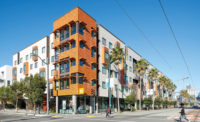San Francisco’s Embarcadero, with its century-old finger piers that jut into the bay, is so integral to the city’s present-day identity that few visitors find their way to another historic stretch of waterfront nearby: a former military port now known as the Fort Mason Center for Arts & Culture that couples stunning views with a sense of seclusion.
The military installation was decommissioned in 1972, and the 13-acre enclave within the Golden Gate National Recreation Area is now managed by a nonprofit that has filled the aged buildings with eclectic tenants, ranging from the venerable Greens vegetarian restaurant to the city public library’s bookstore. The latest arrival is the San Francisco Art Institute, housed in a newly restored pier structure from 1912 that works surprisingly well as an enclosed college campus.
The two-stage, $50 million restoration of what’s known as Pier 2 was completed last fall and fills the onetime army warehouse with such elements as 160 studios for graduate students, two small galleries, and a glassed-in student workshop near the entrance. Though the deference to the past is meticulous, the additions bring a contemporary energy to the gaunt shell of concrete and its wood roof held in place by enormous steel trusses.
Leading the design effort was Leddy Maytum Stacy Architects. It was a natural assignment for the firm, which has restored several buildings in San Francisco’s Presidio and was the architect for the structural remediation of Pier 2, completed in 2014. That effort went beyond seismic upgrades to include a 255-kilowatt photovoltaic (PV) solar panel array on the roof and radiant heating in the concrete mat that preserved the military-era train tracks inside the shed, while providing insulation from the bay.
While that work was under way, the Center was approached by leaders of the Art Institute, which was founded in 1871 and numbers Ansel Adams, Clyfford Still, and Annie Liebovitz among its past students and faculty. The institute needed space for its graduate program; Fort Mason is near Russian Hill, where the Institute is housed in a 1926 Spanish Revival landmark, with a brooding Brutalist wing by Paffard Keatinge-Clay that opened in 1969.
“We thought it was a great fit from the beginning—the volume is so amazing,” says partner-in-charge Marsha Maytum of the pier building. “But there was a lot of discussion about how to insert individual art studios without compromising the drama of the central space.”
The firm’s solution was to create a long nave beneath the 52-foot-tall ceiling, with clerestory windows at its peak. This move preserved natural light and a sense of the rhythmic procession of the trusses, while the architects added mezzanines that flank the long space and hold cul de sac-like clusters of individual studios, enclosed by 8-foot-high walls—another effort to keep the internal additions distinct from the original frame.
The mezzanines meet at a landing reached from below by a broad stair, and it’s a spot where the project’s success at creating intimacy within a statuesque void is particularly clear. The grand stair includes the now-obligatory bleacher-style seating—but Maytum turned the space where the staircase touches down into a nook, with white-oak benches tucked beneath the structural frame.
Another enlivening element is the bridge across the central nave. Not only did Maytum keep it slender and light, a catwalk with open aluminum gratings, but the span is diagonal—a stroke that makes the straightforward volume less static, more dynamic.
These alterations had to pass muster with California’s State Historic Preservation Office and the National Park Service, with an extra layer of review since the client wanted to use federal historic-preservation tax credits.
Aesthetically, the pairing of old and new is a success. More important, it’s a deft fit for an institution that, in turn, benefits Fort Mason as a whole.
“There’s an energy that only art students generate,” says Rich Hillis, executive director of the Fort Mason Center. “Everyone benefits from having that population here. You can feel it.”










Post a comment to this article
Report Abusive Comment